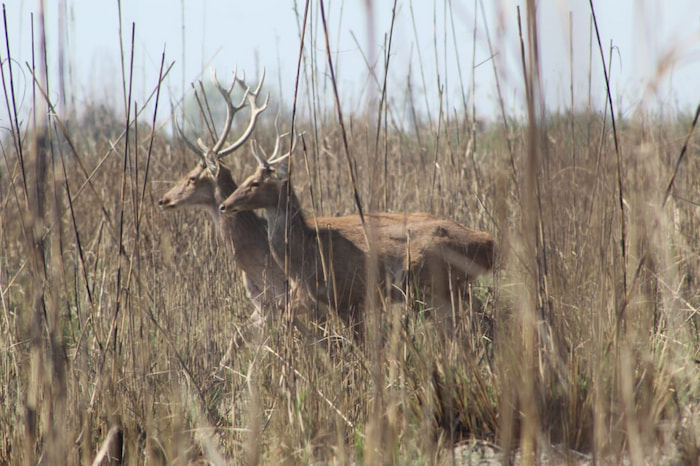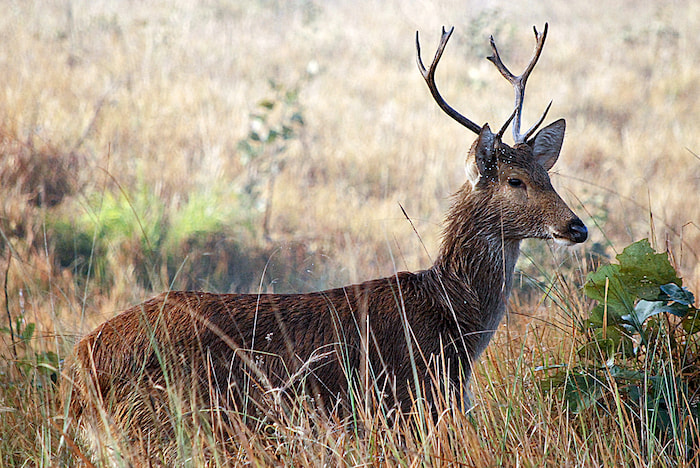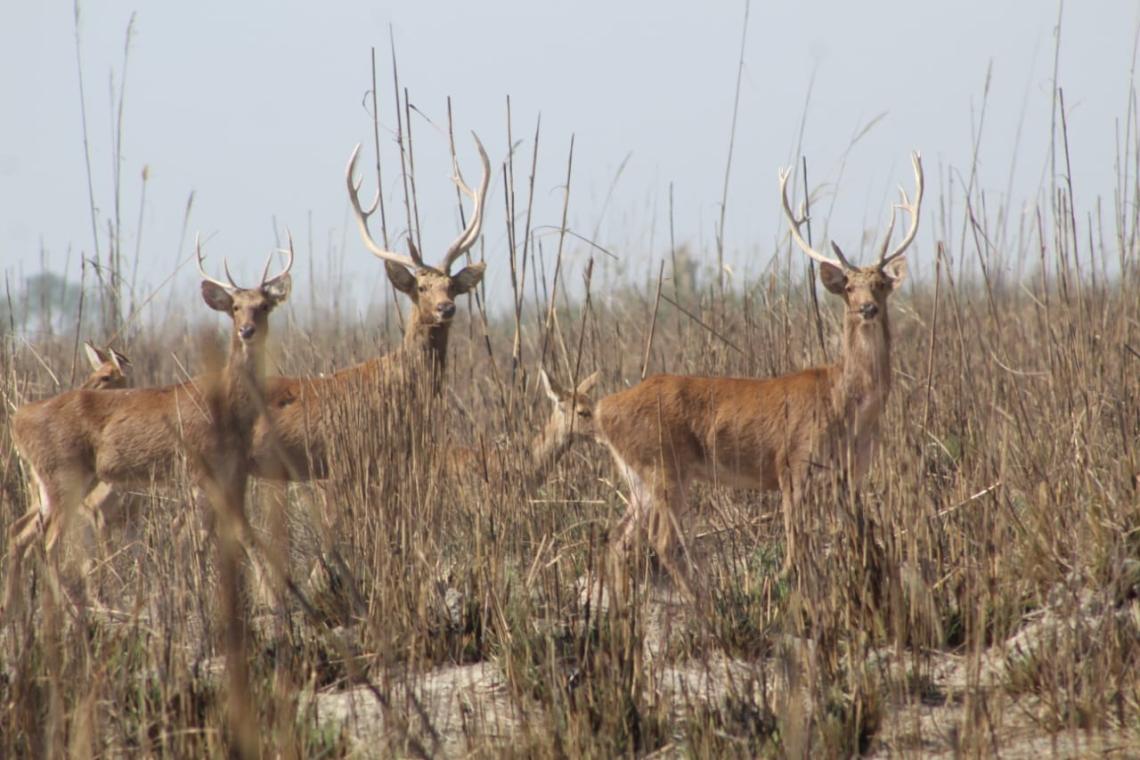In 2017, Abhinaya Pathak, then Assistant Warden of Chitwan National Park, and his team engaged in translocating some swamp deer to CNP in Chitwan, Nepal. The team moved a small herd of swamp deer from Shuklaphanta National Park to Chitwan National Park, where swamp deer had once roamed as early as the 1960s but had since been declared extinct in the park and Chitwan itself. Nonetheless, Pathak notes, “Nepal still has the world’s best swamp deer herd, with more than 2,300 individuals in Shuklaphanta National Park and more than 90 in Bardiya National Park in the Terai Arc Landscape.”
Key Considerations
- Importance of Grasslands: Swamp deer, or Barasingha, are crucial to the health of grassland ecosystems, emphasizing the need to protect and restore these habitats for their survival.
- Challenges of Translocation: Translocating wildlife, especially over long distances, presents significant logistical and ecological challenges that require careful planning, substantial resources, and ongoing management.
- Stakeholder Collaboration: Successful conservation projects demand collaboration between governments, conservation agencies, and local communities, highlighting the importance of inclusive approaches.
- Learning from Setbacks: The failure of the translocation project underscores the complexities of wildlife conservation, where even well-intentioned efforts can face unforeseen challenges like natural disasters and disease outbreaks.
- Adaptive Management: Future conservation initiatives should incorporate lessons learned from past projects, including the need for adaptive management strategies that can respond to unexpected challenges.
Swamp deer are members of the deer family (Cervidae) found on the Indian subcontinent. Locally known as "Barasingha," which means "twelve horns," their antlers typically branch into up to twelve times, hence the name. Barasinghas are large herbivores of grasslands, primarily feeding on short grasses and occasionally on aquatic plants. They play a crucial role in maintaining the health of their native grasslands and are also a significant part of a tiger's diet.
Pathak, now a Ph.D. student at the de Silva Human/Nature Lab at the University of California, San Diego, worked as an Assistant Warden at Chitwan National Park in his home country of Nepal from 2015 to 2018.. He considers himself fortunate to have led the deer translocation project. In collaboration with a range of stakeholders—including the government, national parks, conservation agencies, and local communities—the team set out to relocate five females and two males from Shuklaphanta National Park to Chitwan National Park. They created an enclosure in Padampur within Chitwan National Park, where a large grassland had formed after the removal of a village, leading to the development of a rich grassland. The enclosure was secured with wire and solar fences to deter potential intruders, with occasional doors for staff access. The team released the deer into the enclosure using what they termed a "soft release process." This method involves gradually acclimating animals to their new environment before their full release, aiming to reduce stress and shock, increase their survival rate, and help them adapt more effectively.

Photo by Tathagata Chakraborty
“We lacked experience and faced significant challenges in translocating the deer species over a long distance,” says Pathak, noting that “swamp deer relocation to such a long distance had never been done before in the country.” Managing the deer inside the enclosure after their translocation proved difficult. Pathak recalls that the long-distance transport had already stressed the deer from the outset. He realized that translocating species was no simple task. “Studying and researching a species is one thing, but translocation is entirely different, demanding much more effort and presenting numerous challenges,” Pathak remarks. The project required constant maintenance of the fence, the grassland, and the water holes, which was challenging given the gradually diminishing budget. Despite their best efforts to breed a viable population in the national park, the team ultimately failed as the deer began to die one by one. Pathak explains that during one monsoon, a flood from the Chure region inundated the streams passing through the enclosure and destroyed the fences. “The flood caused additional problems, such as diseases and intruders entering the enclosure,” says Pathak. The flood also degraded the grassland within the enclosure, making the habitat unsuitable for the deer. Pathak notes that a couple of deer had already bitten their tongues within a few months of translocation, and the rest were lost to the flood, leaving only a lone female survivor. “Our project ultimately failed,” Pathak admits. “The animals did their part, but we just couldn’t sustain them after their translocation,” he says. “Funding proved inadequate, as the funding agencies couldn’t provide consistent support after two years, impairing our planning and actions.”

The historical distribution of Barasingha covered the Indo-Gangetic plains and lowlands of the southern Himalayas, including Pakistan, southern Nepal, India, and Bangladesh. There are three known subspecies of swamp deer (Rucervus duvaucelli): the northern (R. duvaucelli duvaucelli), the central (R. duvaucelli branderi), and the eastern (R. duvaucelli ranjitsinhi). The northern subspecies comprises 80% of the global swamp deer population, while the other two subspecies account for the remaining 20%. Currently, the total global population of swamp deer is less than 5,000 individuals, with the subspecies being fragmented and restricted to parts of northern, northeastern, and central India, and southwestern Nepal. They are classified as “Vulnerable” by the IUCN due to severe population declines and habitat contraction over the last century. They are listed under Appendix I by CITES. In Nepal, however, they have been granted “Protected” status by the government.
“Swamp deer are typically found near rivers with associated grasslands and wetlands,” said Dr Shrutarshi Paul, a Postdoctoral Research Associate at Texas A&M University, who has dedicated the past eight years, starting in 2015, to researching these twelve-tined deer in the swamps of India. He began his research on the Barasingha when he joined the Wildlife Institute of India for his Ph.D. in 2015. Although he was aware of the deer’s threatened status, he hadn’t anticipated that he would be working on it for the next seven or eight years. “The deer evolved in a habitat dominated by three major rivers in the northern part of the Indian subcontinent: the Indus, the Ganga, and the Brahmaputra,” states Paul. “Similar to the distribution of the rhino or hog deer, swamp deer were once distributed identically across the habitat,” he adds. “However, habitat degradation has severely impacted these species.” Paul and his colleagues wrote in their 2020 paper that “Swamp deer, the obligate grassland-dwelling endemic cervid, is the most extinction-prone megaherbivore in the Indian subcontinent.”
“These deer primarily reside in wetlands with grasses such as Phragmites, Typha, and Saccharum species,” says Paul. The deer prefer a mix of these grasses for grazing. “While they may stay in swamps, they occasionally venture into dry areas to bask before retreating back to their swamps, or when they are threatened,” Paul explains. Interestingly, Paul and his colleagues have observed that these deer also colonize agricultural areas. “In the northern region, most of their habitats have been converted into sugarcane fields, the most abundant crop in the Gangetic plain,” states Paul. He notes that these sugarcane fields provide temporary shelter for the deer during certain times of the year. Paul adds that the deer frequently use agricultural fields to move between grassland patches along the river. He mentions that they have received numerous complaints from local communities about swamp deer damaging crops, but he emphasizes that “it’s crucial to quantify the extent of this impact.” He questions, “Are they causing significant agricultural damage, or is there confusion with other species like the Nilgai, which resembles a swamp deer?”
Paul and his team, who have researched these species throughout the entire Upper Gangetic plain, have studied many aspects of the deer. “They have splayed hooves that help them navigate through wetlands easily,” says Paul. “This adaptation enables them to cross rivers, both large and small, with ease.” Paul realized these creatures are excellent swimmers when he observed radio-collared deer regularly crossing the banks of the Ganga River. However, this behavior occasionally exposes them to the risk of “getting swept away by the river current.” Paul noted that in Hastinapur Wildlife Sanctuary, one of their research sites, a dam collects animals, including swamp deer, that have been swept upstream by the current. “The rescue team then retrieves the animals,” he explains.
Interestingly, in Nepal, the name “Barasingha” is now more commonly associated with a beer brand than with the actual animal. Though it may seem humorous, the only Barasingha now found in the Chitwan district—once home to many swamp deer—is the beer, not the animal itself. The Barasingha Brewery, located in Chitwan district (home to Chitwan National Park), has quickly gained popularity for its variety of beer products and supports the conservation of Nepal’s wilderness, including its namesake animal, as stated on its website. When I reached out to the factory manager to inquire about their conservation efforts beyond just using the animal’s name and image on their beer bottles, the owners replied that they are currently operating at a loss and “will certainly work towards the conservation and management of these species once they become profitable.” Coincidentally, Pathak and his team had also translocated some water buffaloes, called “Arna,” into Chitwan National Park from the Koshi Tappu Wildlife Reserve, where they were kept in the same enclosure as the swamp deer. Pathak notes that both species’ names have become popular alcoholic beverage brands. “While alcohol may seem unrelated, these brands can raise awareness,” says Pathak. “For instance, our national cricket team features the Greater one-horned rhinoceros in its logo, which attracts attention and sparks curiosity about the species. These are charismatic animals that can capture people's interest. When someone sees Barasingha beer, they might wonder, 'What is this animal? Does it really have twelve horns?' This curiosity can lead to greater awareness and interest in conservation, even among those who previously didn’t know about these animals.” While the beer brand certainly draws attention to this charismatic deer species, what actual on-the-ground efforts the company will devote to conservation remains to be seen.
“There isn't a one-size-fits-all solution for swamp deer conservation, as each landscape is unique and requires strategies that address its specific complexities and dynamics,” says Paul. He conducted his research on the northern swamp deer species, which are present in two distinct river basins: the Ganga and the Sharada. “For instance, the conservation approach for the Sharada River, where the majority of the swamp deer population is in protected areas, differs significantly from that for the Ganga River, where most areas are non-protected and local communities play a crucial role,” Paul explains. He believes it is essential to involve local communities alongside other stakeholders in the Ganga basin. “Building strong connections among all relevant stakeholders is vital, especially considering the dynamic nature of river landscapes, where landforms change and disputes over newly formed lands often arise,” says Paul. “In such non-protected landscapes, merging efforts from all stakeholders is crucial.” Both Paul and Pathak agree that preventing extreme habitat degradation along the river basins is key to maintaining these deer populations in the long run. Paul notes that even a kilometer of undisturbed habitat along the river can support the deer. “In Shuklaphanta in Nepal, highways and large canals create a conflicting scenario where people require both development and conservation, which has proven contradictory and has impacted conservation efforts,” Pathak explains. “Generally, people do not focus as much on researching deer species as they do on rhinos, tigers, and elephants,” Pathak adds. He calls for more attention from the government and NGOs to research these species. Meanwhile, Paul emphasizes that relocation is also an important method for maintaining the deer, as “each species plays a unique role in its habitat, and for these deer, it is grazing and wading through swamps.”
When asked about the potential impact on their native ecosystem if these deer species were to go completely extinct, Pathak responds, “Each species has a unique position and role in its ecosystem. The Barasingha, by grazing, maintains large grasslands and prevents tree encroachment within these grasslands.” He explains that they browse saplings that grow in their grasslands, thereby helping to sustain their native grassland ecosystem. Additionally, Pathak notes that they play a significant role in the health of water swamps as they move through and excrete in these areas. “In habitats where they have already gone extinct, like Chitwan National Park, the absence of Barasingha can lead to changes in grassland dynamics and water hole ecosystems, potentially affecting other species and the overall health of the habitat.”
Paul believes that Barasingha hunting, which is quite popular in India, is not a grave threat to these species. He further states that occasional killing for bush meat by tribal communities is also not a significant threat to their survival. “If hunting were the most significant pressure, the swamp deer in the Ganga Basin, an area with high human disturbance, would likely have gone extinct by now,” Paul asserts. “The primary focus should be on habitat conservation. As Dr. Ranjit Singh aptly put it, ‘Save the grasslands, you save the Barasingha.’”
Main photo by Tathagata Chakraborty


